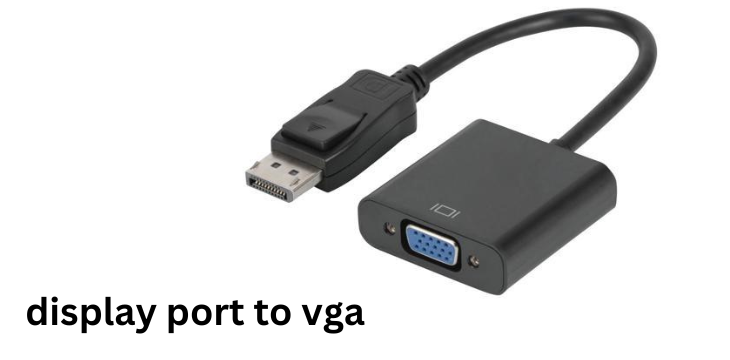Outline Of The Table
- Introduction to Display Port to VGA
- Understanding DisplayPort and VGA
- What is DisplayPort?
- What is VGA?
- Advantages and Disadvantages of DisplayPort and VGA
- Advantages of DisplayPort
- Disadvantages of DisplayPort
- Advantages of VGA
- Disadvantages of VGA
- Why Use DisplayPort to VGA Adapters?
- How Do DisplayPort to VGA Adapters Work?
- Choosing the Right DisplayPort to VGA Adapter
- Compatibility
- Resolution Support
- Build Quality
- Setting Up a DisplayPort to VGA Connection
- Common Issues and Troubleshooting
- The Future of DisplayPort and VGA
- Conclusion
Introduction to Display Port to VGA
In the digital age, where high-definition displays dominate the market, there’s still a need to connect older VGA monitors or projectors to modern devices equipped with DisplayPort outputs. This is where DisplayPort to VGA adapters come into play, bridging the gap between old and new technologies.
Understanding Display Port and VGA
What is display port to vga?
display port to vga is a digital interface primarily used to connect a video source to a device such as a computer monitor, TV, or projector. It supports high resolutions and refresh rates, making it ideal for multimedia applications and gaming.
What is display port to vga?
VGA (Video Graphics Array) is an analog display standard introduced by IBM in 1987. Despite its age, VGA is still widely used, especially in older monitors, projectors, and some legacy devices.
Advantages and Disadvantages of display port to vga
Advantages of display port to vga
- High resolution support
- High refresh rates
- Audio support
- Versatile connectivity options (DisplayPort 1.4 supports daisy chaining)
Disadvantages of display port to vga
- Limited compatibility with older VGA devices
- Different versions may have varying features and capabilities
Advantages of display port to vga
- Wide compatibility with older devices
- Simple and inexpensive
Disadvantages of display port to vga
- Analog signal prone to interference and signal degradation
- Limited resolution and refresh rate support compared to DisplayPort
Why Use display port to vga Adapters?
DisplayPort to VGA adapters allow users to connect newer devices with DisplayPort outputs to older VGA displays or projectors. This is particularly useful in environments where upgrading to newer displays is not feasible or cost-effective.
How Do display port to vga Adapters Work?
These adapters convert the digital signal from the DisplayPort output into an analog signal compatible with VGA displays. They typically incorporate a small chipset to perform this conversion, ensuring seamless compatibility between the two technologies.
Choosing the Right display port to vga Adapter
Compatibility
Ensure the adapter is compatible with both your DisplayPort source and VGA display. Check for compatibility with different versions of DisplayPort and VGA standards.
Resolution Support
Choose an adapter that supports the resolution of your VGA display. Some adapters may have limitations on supported resolutions, so verify compatibility before purchasing.
Build Quality
Opt for adapters with sturdy construction and reliable connectors to ensure a stable connection and longevity.
Setting Up a displayport to vga Connection
- Connect the DisplayPort end of the adapter to the DisplayPort output on your device.
- Connect the VGA end of the adapter to the VGA input on your display or projector.
- Power on both devices and select the appropriate input source on your display.
Common Issues and Troubleshooting
- No display output: Ensure all connections are secure and the adapter is properly configured.
- Poor image quality: Check for loose connections or signal interference.
- Unsupported resolution: Verify that your adapter supports the resolution of your display.
The Future of displayport to vga
As technology continues to evolve, the demand for older analog standards like VGA may decline further. However, DisplayPort to VGA adapters will likely remain relevant for the foreseeable future, serving as a bridge between legacy and modern display technologies.
Conclusion
DisplayPort to VGA adapters offer a simple yet effective solution for connecting older VGA displays to modern devices with DisplayPort outputs. By understanding their capabilities and limitations, users can make informed decisions when choosing and using these adapters, ensuring seamless connectivity and compatibility.
FAQs
- Can I use a DisplayPort to VGA adapter with a Macbook?
- Yes, most Macbooks with DisplayPort outputs are compatible with DisplayPort to VGA adapters.
- Do DisplayPort to VGA adapters support audio?
- No, DisplayPort to VGA adapters only transmit video signals. You will need a separate audio connection for sound.
- Can I use a DisplayPort to VGA adapter for gaming?
- While DisplayPort to VGA adapters can be used for gaming, they may have limitations on supported resolutions and refresh rates compared to direct digital connections.
- Will a DisplayPort to VGA adapter degrade image quality?
- In general, the quality of the image will be slightly degraded due to the analog nature of VGA signals. However, with a high-quality adapter and proper setup, the difference may not be noticeable.
- Are there any alternatives to DisplayPort to VGA adapters?
- Yes, there are alternatives such as HDMI to VGA adapters or USB-C to VGA adapters, depending on the ports available on your devices.
